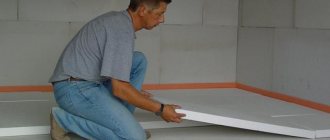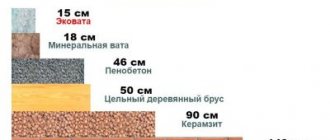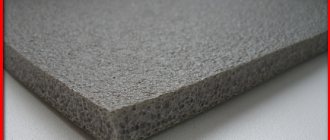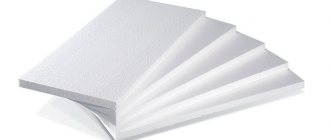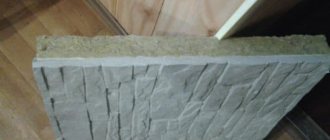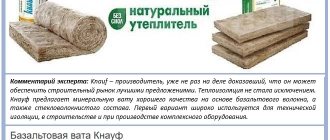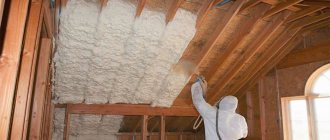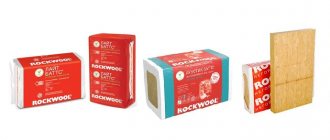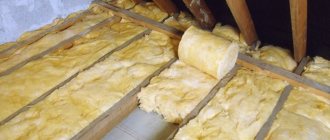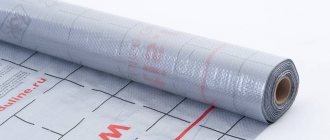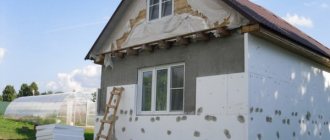Main characteristics of insulation
Let us first provide the characteristics of the most popular thermal insulation materials, which you should first pay attention to when choosing. Comparison of thermal conductivity insulation should be made only on the basis of the purpose of the materials and room conditions (humidity, presence of open fire, etc.). We have further arranged in order of importance the main characteristics of insulation.
Comparison of building materials
Thermal conductivity . The lower this indicator, the less thermal insulation layer is required, which means that insulation costs will also be reduced.
Moisture permeability . The lower permeability of the material to moisture vapor reduces the negative impact on the insulation during operation.
Fire safety . Thermal insulation should not burn or emit toxic gases, especially when insulating a boiler room or chimney.
Durability . The longer the service life, the cheaper it will cost you during operation, since it will not require frequent replacement.
Environmental friendliness . The material must be safe for humans and the environment.
Comparison of insulation materials by thermal conductivity
Economical . The material must be accessible to a wide range of consumers and have an optimal price/quality ratio.
Easy to install . This property for a thermal insulation material is very important for those who want to make repairs themselves.
Thickness and weight of the material . The thinner and lighter the insulation, the less heavy the structure will be when installing thermal insulation.
Soundproofing .
The higher the sound insulation value of the material, the better the protection in the living room from extraneous noise from the street.
Service life of foam plastic as insulation
Another frequently used insulation material is polystyrene foam. It is generally accepted that the shelf life of expanded polystyrene reaches several decades.
Manufacturers guarantee the durability of the material for 50 years. However, with the correct insulation procedure, this period can be doubled. This is one of the main reasons why it is so popular.
It should be borne in mind that there are several types of insulation made from polystyrene foam:
Polystyrene. A material made in the form of foam rubber. Suitable for protecting a room from the inside.
Has very high performance characteristics. Polyvinyl chloride substances are very elastic. They have a very high resistance index. Polyurethane foam. It is considered a durable thermal insulation that will last for quite a long time, hardens quickly, forming a very strong protection that can withstand many external influences.
Based on the above materials, we can conclude that the service life of polystyrene foam is very long and fully lives up to expectations.
Today, manufacturers of thermal insulation materials offer developers a truly huge selection of materials.
At the same time, everyone assures us that their insulation is ideal for insulating a house. Due to such a variety of building materials, making the right decision in favor of a particular material is really quite difficult. In this article, we decided to compare insulation materials in terms of thermal conductivity and other equally important characteristics.
It’s worth first talking about the main characteristics of thermal insulation that you need to pay attention to when purchasing. Comparisons of insulation by characteristics should be made keeping in mind their purpose. For example, despite the fact that XPS extrusion is stronger than mineral wool, but near an open fire or at high operating temperatures, it is worth buying fire-resistant insulation for your own safety.
Comparison of insulation materials by thermal conductivity
Expanded polystyrene (foam)
Expanded polystyrene (foam) slabs
This is the most popular thermal insulation material in Russia, due to its low thermal conductivity, low cost and ease of installation. Polystyrene foam is produced in slabs with a thickness of 20 to 150 mm by foaming polystyrene and consists of 99% air. The material has different densities, has low thermal conductivity and is resistant to humidity.
Due to its low cost, expanded polystyrene is in great demand among companies and private developers for insulating various premises. But the material is quite fragile and ignites quickly, releasing toxic substances when burned. Because of this, it is preferable to use polystyrene foam in non-residential premises and for thermal insulation of non-loaded structures - insulation of facades under plaster, basement walls, etc.
Extruded polystyrene foam
Penoplex (extruded polystyrene foam)
Extrusion (technoplex, penoplex, etc.) is not exposed to moisture and rotting. This is a very durable and easy-to-use material that can be easily cut with a knife to the desired size. Low water absorption ensures minimal changes in properties at high humidity; the slabs have high density and compression resistance. Extruded polystyrene foam is fireproof, durable and easy to use.
All these characteristics, along with low thermal conductivity in comparison with other insulation materials, make Technoplex, URSA XPS or Penoplex slabs an ideal material for insulating strip foundations of houses and blind areas. According to the manufacturers, an extrusion sheet 50 millimeters thick replaces 60 mm of foam block in terms of thermal conductivity, while the material does not allow moisture to pass through and you can do without additional waterproofing.
Mineral wool
Izover mineral wool slabs in packaging
Mineral wool (for example, Izover, URSA, Tekhnoruf, etc.) is produced from natural materials - slag, rocks and dolomite using special technology. Mineral wool has low thermal conductivity and is absolutely fireproof. The material is produced in slabs and rolls of varying hardness. Less dense mats are used for horizontal planes; rigid and semi-rigid slabs are used for vertical structures.
However, one of the significant disadvantages of this insulation, like basalt wool, is low moisture resistance, which requires additional moisture and vapor barrier installations when installing mineral wool. Experts do not recommend using mineral wool for insulation of wet rooms - basements of houses and cellars, for thermal insulation of steam rooms from the inside in baths and dressing rooms. But even here it can be used with proper waterproofing.
Basalt wool
Rockwool basalt wool slabs in packaging
This material is produced by melting basalt rocks and blowing the molten mass with the addition of various components to obtain a fibrous structure with water-repellent properties. The material is non-flammable, safe for human health, and has good thermal insulation and sound insulation properties. It is used for both internal and external thermal insulation.
When installing basalt wool, you should use protective equipment (gloves, a respirator and goggles) to protect the mucous membranes from cotton wool microparticles. The most famous brand of basalt wool in Russia is materials under the Rockwool brand. During operation, the thermal insulation slabs do not compact or cake, which means that the excellent properties of low thermal conductivity of basalt wool remain unchanged over time.
Penofol, isolon (foamed polyethylene)
Foil penofol
Penofol and isolon are roll insulation materials with a thickness of 2 to 10 mm, consisting of polyethylene foam. The material is also available with a layer of foil on one side to create a reflective effect. The insulation is several times thinner than previously presented insulation materials, but at the same time retains and reflects up to 97% of thermal energy. Foamed polyethylene has a long service life and is environmentally friendly.
Isolon and foil penofol are lightweight, thin and very easy to use thermal insulation materials. Roll insulation is used for thermal insulation of wet rooms, for example, when insulating balconies and loggias in apartments. Also, the use of this insulation will help you save useful space in the room when insulating inside. Read more about these materials in the section “Organic thermal insulation”.
What is thermal conductivity and what is it like?
Any solid body requires a certain time to cool or warm up, and we are not talking about the surface of the body, but about its entire volume. Thus, thermal conductivity is the ability of a body to transmit thermal energy through a volume, while it is expressed quantitatively by a coefficient.
Metal materials have the highest thermal conductivity coefficients, while heat insulators, for example, foam plastic or brick, conduct heat hundreds of times worse.
The thermal conductivity coefficient determines the ability of a material to retain thermal energy. In the case of mineral wool and other similar insulation materials, we are talking about the amount of heat that is lost per square meter of area with a thickness of 1 m in 1 hour and a temperature difference of 1 degree Celsius.
To install a reliable layer of thermal insulation, insulation materials are chosen, including those based on mineral wool with the lowest thermal conductivity coefficients. Typically these are insulators with a cellular porous surface that can guarantee an optimal amount of heat.
It is believed that the more rigid the thermal insulation material, the lower its thermal conductivity.
For mineral wool slabs, thermal conductivity coefficients range between 0.032 and 0.039 W/(m°C). If we compare the frequently used foam plastic for thermal insulation with mineral wool, it becomes clear that the level of thermal conductivity of these materials is almost the same, despite the fact that in terms of quality characteristics the latter is noticeably inferior to insulation based on mineral wool.
Comparison of insulation materials. Thermal conductivity table
Comparison of foam block, mineral wool and polystyrene foam by thermal conductivity
The table above comparing thermal insulation by thermal conductivity gives a complete picture of which material is best to use. All that remains is to compare the data from the thermal conductivity table with the cost of thermal insulation from suppliers. In this case, it is necessary to accurately calculate the required thickness of insulation when using various materials in order to select the required amount of material.
Mineral wool: characteristics and properties
Thermal conductivity and features of mineral wool
The thermal conductivity of mineral wool depends on the brand and composition. On average, the indicators are 0.034-0.05 W/m*K. The data is very low, so mineral wool is an excellent thermal insulation material.
The looser structure of mineral wool has a lower level of thermal conductivity, so heat is better retained in air “cushions”.
Heavy mineral wool has a thermal conductivity of 0.48-0.55 W/m*K, while light mineral wool (with a loose structure) has a thermal conductivity of 0.035-0.047 W/m*K. Table 1 will help you compare the thermal conductivity of mineral wool with different types of insulation.
| Material name | Thermal conductivity coefficient, W/m*K |
| Polyurethane foam | 0,025 |
| Foam rubber | 0,03 |
| Lightweight cork sheets | 0,035 |
| Fiberglass | 0,036 |
| Styrofoam | 0,037 |
| Expanded polystyrene | 0,04 |
| Foam rubber | 0,04 |
| Light mineral wool | 0,039-0,047 |
| Glass wool | 0,05 |
| Cotton wadding | 0,055 |
The lower the thermal conductivity value, the better the insulation. Compared to expanded polystyrene and polystyrene foam, mineral wool provides less efficient energy consumption. But, if you compare the fire resistance and harmfulness of these insulation materials, then mineral wool clearly wins.
Retains heat equally:
- extruded polystyrene foam (40 kg/m 3 ) with a layer thickness of 95 mm;
- mineral wool (125 mg/m 3 ) - 100 mm;
- Chipboard (400 kg/m 3 ) - 185 mm;
- wood (500 kg/m 3 ) - 205 mm.
Mineral wool has a low thermal conductivity coefficient, so it is used everywhere. It is used for insulation of building facades, for internal and external insulation.
Selection of mineral wool and calculation of insulation thickness
Any building has its own thermal resistance standard. The numbers depend on the climate zone and differ depending on the region.
Each insulation has its own level of thermal conductivity
Therefore, it is important to create comfortable thermal insulation conditions that will reduce energy consumption for heating and cooling the room
If the building has already been built, calculations must be carried out based on the type of material, its cross-section, thermal conductivity calculations, and figures for thermal insulation. For houses that are just under construction, there are more options for choosing building materials, insulation and finishing.
To calculate the thickness of the insulation you need to know three numbers:
- regional standards for thermal resistance of buildings;
- thermal resistance coefficient of the building material of the structure;
- thermal conductivity coefficient of insulation.
Calculate using the formula:
K = R/N,
where K is the figure of the wall’s thermal resistance; R is the thickness of the insulation layer; N is the thermal conductivity coefficient.
This formula will help calculate the thermal resistance of the wall. And, based on the data obtained, it is possible to calculate what thickness of thermal insulation is needed. You will find a complete calculation of the insulation thickness in the article “Insulation thickness for walls.”
Technical characteristics of mineral wool as insulation
Each thermal insulation material is good in its own way. Mineral wool included.
Even more: it is in many ways better than other insulation materials, because... It is environmentally friendly, does not harm health, is easy to install and retains its performance properties for a long time.
For example, in Table 2 we compare the technical characteristics of mineral wool and extruded polystyrene foam.
| Characteristic name | Mineral wool | Extruded polystyrene foam |
| Compressive strength at 10% linear deformation, MPa | 37-190 (+/- 10%) | 28-53 (+/- 10%) |
| Water absorption by volume over 24 hours | less than 0.4 | 0,2-0,4 |
| Self-combustion time, no more, s | non-flammable material | poisonous gases dissipate |
| Fire technical characteristics according to SNiP 21-01-97 | NG, T2 | G1, D3, RP1 |
| Operating temperature range, °C | -180 to +650°С |
At t ≥ 250°C the binder evaporates. Melts at 1000°C
-50 to +75 °С
At 200-250°C heat, toxic substances decompose
Vapor permeability coefficient, mg/(m.h. Pa) 0.31-0.032 0.007-0.012
Security + –
Thermal resistance 0.036-0.045 0.03-0.033
Soundproof and windproof + +
Moisture resistance + +
High load resistance – +
Maintaining stable dimensions – +
Durability 50 years (actual – 10-15 years) 50 years (actual – more than 20 years)
Ease of use + +
Retardant of flammability + –
Thermal conductivity of mineral wool
If we compare the thermal conductivity of mineral wool with the thermal conductivity of other thermal insulation materials, we get the following indicators:
Thermal conductivity, W/m °C / required thickness of insulation layer, mm:
Basalt wool – 0.039/167 mm Expanded polystyrene – 0.037/159 mm Glass wool – 0.044/189 mm Expanded clay – 0.170/869 mm Brickwork – 0.520/1460 mm
Comparative thermal conductivity coefficients of building materials:
Concrete – 1.5 Mortared masonry – 1.2 Working brick – 0.6 Facing brick – 0.4 Plaster – 0.3 Cellular concrete – 0.2 Glass wool – 0.05 Cork coverings – 0.039 Mineral wool – 0.035 Foam plastic – 0.034
As can be seen from the indicators, the thermal conductivity of mineral wool is second only to expanded polystyrene materials. Although if you compare polystyrene foam and stone wool in terms of fire resistance, then stone wool is definitely the winner. All types of stone wool are classified as non-combustible materials.
